Computational Model Development for Hybrid Tilting Pad Journal Bearings Lubricated with Supercritical Carbon Dioxide
Abstract
:Featured Application
Abstract
1. Introduction
2. Hybrid TPJB Lubricated with sCO2 and Its Computational Model
2.1. Thermohydrodynamic Model for Turbulent Compressible Fluid Flows
2.2. Real Gas Model for sCO2
2.3. Boundary Conditions for Pressure and Temperature
3. Numerical Procedure
- The bearing geometry, lubricant properties at the initial condition, the initial guesses for the pad tilting angle δ, pivot deflection ζ, eccentricity ratio ϵ, the angle between the X-axis and the line of the centers θc, and the pressure ratios pratio (pre/ps), pratiod (pdc/ps), pratioa (pda/ps) are provided as the input. For the initial guess for δ, Equation (4) assumes zero film thickness at the trailing edge of a pad, which indicates the maximum δ. Half of the maximum δ is then taken as the initial guess for δ of each pad. The initial guess for ζ is 0.1% of the bearing clearance. Similarly, the initial guess for ε, pratio, pratiod, and pratioa must be positive and less than 1, and θc is guessed to be 90°, indicating that the rotor is displaced only in the vertical direction.
- The finite element method solves the Reynolds equation to compute the pressure distribution over each pad. The generated hydrodynamic pressure exerts a force Fpad on the surface of the pad, which deflects the supporting pivot and gives rise to a restoring force Fp in it [28]. As shown in Equation (13), TPJB with the number of pads Npad in the static equilibrium requires that Fp balance Fpad all the moments and bearing horizontal force FX balance to zero, the bearing vertical force FY balance the static load Fp0, and the orifice flow rate Qo balance the summation of the flow rates at the recess boundaries Qr. The circumferential and axial pressure drops at the recess edges due to inertia are also calculated iteratively as follows:where i and i − 1 denote the current and previous iterations, respectively. The Newton–Raphson method calculates the equilibrium position.
- Once the static equilibrium position converges, the thermal energy mixing model calculates the fluid’s inlet temperature at the pad’s leading edge. The control-volume finite difference technique with an upwind scheme solves the two-dimensional energy equation (Equation (9)) for the temperature distribution (see Ref. [34] for more details).
- The converged pressure and temperature are then used to calculate the density and viscosity.
- Once the density and viscosity are converged iteratively using the successive substitution method, the journal is perturbed to a new position, and static equilibrium is achieved again.
- The stiffness and damping coefficients are calculated from the ratio of the difference between the forces at the new and old equilibrium positions to the difference in distance and velocity, respectively, at both points. Note that the squeeze velocity term given on the right-hand side of the Reynolds equation accommodates the calculation of stiffness and damping coefficients.
4. Model Validations
4.1. Density and Viscosity of sCO2
4.2. Fixed-Pad Hydrodynamic Journal Bearings
4.3. Fixed-Pad Hydrostatic and Hybrid Journal Bearings
5. Results
6. Conclusions
Author Contributions
Funding
Institutional Review Board Statement
Informed Consent Statement
Data Availability Statement
Acknowledgments
Conflicts of Interest
Nomenclature
| (a…g)1…4 | Empirical coefficients |
| Ao | Orifice area [m2] |
| b | Recess axial length [m] |
| Cd | Orifice discharge coefficient [-] |
| Cb | Radial bearing clearance [m] |
| cp | Specific heat capacity at constant pressure [J/kg/K] |
| cv | Specific heat capacity at constant volume [J/kg/K] |
| Cp | Radial pad clearance [m] |
| Cα,β = X,Y | Damping coefficient |
| do | Orifice diameter [m] |
| Dr | Recess depth [m] |
| e | Eccentricity [m] |
| Fp | Pivot restoring force [N] |
| Fpad | Force on pad [N] |
| Fpo | Bearing static load [N] |
| FX | Horizontal direction fluid film force [N] |
| FY | Vertical direction fluid film force [N] |
| Gx | Turbulent coefficient in circumferential direction [-] |
| Gz | Turbulent coefficient in axial direction [-] |
| h | Film thickness [m] |
| hl | Film thickness at a land area adjacent to recess [m] |
| hre | Film thickness at recess area adjacent to film land [m] |
| htj | Convective heat transfer coefficient to journal surface [W/m2·K] |
| htb | Convective heat transfer coefficient to bearing [W/m2·K] |
| Kα,β = X,Y | Stiffness coefficient |
| L | Bearing axial length [m] |
| l | Recess circumferential length [m] |
| l11, l21, l81, l82 | Empirical coefficients |
| M | Pad moment [N.m] |
| m | Preload factor (1 − Cb/Cp) [-] |
| m0, n0 | Empirical constants used for calculating turbulent coefficients |
| Mo | Orifice mass flow rate [kg/s] |
| Npad | Number of pads [-] |
| p | Fluid film pressure [Pa] |
| pa | Ambient pressure [Pa] |
| pc | Critical point pressure of CO2 [Pa] |
| pdc | Pressure drop due to inertia at the circumferential trailing edge of the recess [Pa] |
| pda | Pressure drop due to inertia at the axial trailing edge of the recess [Pa] |
| ps | Supply pressure of the externally pressurized fluid [Pa] |
| pr | Ratio of local pressure to critical pressure of sCO2 [-] |
| pratio | Ratio of recess pressure to supply pressure [-] |
| pre | Recess pressure [Pa] |
| Ql | Flow flux at the land adjacent to recess boundary [m2/s] |
| Qo | Orifice volumetric flow rate [m3/s] |
| Qr | Summation of the flow rates at the recess boundaries [m3/s] |
| Re | Reynolds number [-] |
| Rec | Critical Reynolds number [-] |
| Rh | Pivot’s housing radius [m] |
| Rp | Pad radius [m] |
| Rg | Gas constant [J/kg/K] |
| rp | Preload [m] |
| t | time [s] |
| tp | pad thickness [m] |
| T | Fluid film temperature [°C] |
| Tb | Bearing temperature [°C] |
| Tc | Critical point temperature of CO2 [°C] |
| Tj | Journal temperature [°C] |
| Tr | Ratio of local temperature to the critical temperature of sCO2 [-] |
| Ts | Fluid film supply temperature [°C] |
| T* | Reduced temperature of CO2 [°C] |
| U | Journal surface speed [m/s] |
| V | Bulk flow velocity in the circumferential direction [m/s] |
| W | Bulk flow velocity in the axial direction [m/s] |
| X, Y | Inertial coordinates [m] |
| x | Circumferential coordinate [m] |
| z | Axial coordinate [m] |
| δ | Pad’s tilting angle [rad] |
| β | Fluid’s thermoviscosity coefficient [°C−1] |
| βt | Fluid’s thermal expansion coefficient [°C−1] |
| βl | Reynolds number dependent coefficient in the land area used in the calculation of pressure drop |
| βre | Reynolds number dependent coefficient in recess area used in the calculation of pressure drop |
| ρ | Fluid’s local density [kg·m−3] |
| ρ0 | Fluid density at the initial condition [kg·m−3] |
| ζ | Deflection of pivot [m] |
| µ | Fluid’s local viscosity [Pa·s] |
| µ0 | Fluid’s viscosity at initial condition [Pa·s] |
| θ | Circumferential coordinate [rad] |
| θc | Angle between a line passing through bearing and journal centers and horizontal axis [rad] |
| θp | Pivot’s angular location [rad] |
| θpad | Pad’s angular extent [rad] |
| ν | Poisson’s ratio |
| Ω | Journal rotational speed [rad·s−1] |
| κ | ratio of the specific heat capacity at constant pressure to the specific heat capacity at constant volume [-] |
| (λ)0…4 | Empirical coefficients |
Appendix A. Pad Tilting Angle, Pivot Deflection, and Pivot Maximum Stress
References
- Brun, K.; Friedman, P.; Dennis, R. Fundamentals and Applications of Supercritical Carbon Dioxide (SCO2) Based Power Cycles; Brun, K., Friedman, P., Richard, D., Eds.; Woodhead Publishing: Sawston, UK, 2017; ISBN 9781845697693. [Google Scholar]
- Wright, S.A.; Radel, R.F.; Vernon, M.E.; Rochau, G.E.; Pickard, P.S. Operation and Analysis of a Supercritical CO2 Brayton Cycle; Sandia National Laboratory: Albuquerque, NM, USA, 2010. [Google Scholar]
- Conboy, T.; Wright, S.; Pasch, J.; Fleming, D.; Rochau, G.; Fuller, R. Performance characteristics of an operating supercritical CO2 Brayton cycle. J. Eng. Gas Turbines Power 2012, 134, 111703. [Google Scholar] [CrossRef]
- Turchi, C.S.; Ma, Z.; Neises, T.W.; Wagner, M.J. Thermodynamic study of advanced supercritical carbon dioxide power cycles for concentrating solar power systems. J. Sol. Energy Eng. 2013, 135, 041007. [Google Scholar] [CrossRef]
- Dostal, V.; Hejzlar, P.; Driscoll, M.J. High-performance supercritical carbon dioxide cycle for next-generation nuclear reactors. Nucl. Technol. 2006, 154, 265–282. [Google Scholar] [CrossRef]
- Uusitalo, A.; Ameli, A.; Turunen-Saaresti, T. Thermodynamic and turbomachinery design analysis of supercritical Brayton cycles for exhaust gas heat recovery. Energy 2019, 167, 60–79. [Google Scholar] [CrossRef]
- Cho, J.; Choi, M.; Baik, Y.-J.; Lee, G.; Ra, H.-S.; Kim, B.; Kim, M. Development of the turbomachinery for the supercritical carbon dioxide power cycle. Int. J. Energy Res. 2016, 40, 587–599. [Google Scholar] [CrossRef]
- Cho, J.; Shin, H.; Ra, H.S.; Lee, G.; Roh, C.; Lee, B.; Baik, Y.J. Development of the supercritical carbon dioxide power cycle experimental loop in KIER. In Proceedings of the ASME Turbo Expo 2016: Turbomachinery Technical Conference and Exposition, Seoul, Korea, 13–17 June 2016; Volume 9, pp. 1–8. [Google Scholar]
- Ahn, Y.; Lee, J.; Kim, S.G.; Lee, J.I.; Cha, J.E. The design study of supercritical carbon dioxide integral experimental loop. In Proceedings of the ASME Turbo Expo 2013: Turbine Technical Conference and Exposition, San Antonio, TX, USA, 3–7 June 2013; pp. 1–7. [Google Scholar]
- Utamura, M.; Hasuike, H.; Yamamoto, T. Demonstration test plant of closed cycle gas turbine with supercritical CO2 as working fluid. Strojarstvo 2010, 52, 459–465. [Google Scholar]
- Conboy, T.M. Real-gas effects in foil thrust bearings operating in the turbulent regime. J. Tribol. 2013, 135, 031703. [Google Scholar] [CrossRef]
- Lemmon, E.W.; McLinden, M.O.; Huber, M.L. NIST Reference Fluid Thermodynamic and Transport Properties-REFPROP. Available online: https://webbook.nist.gov/chemistry/fluid/# (accessed on 1 January 2019).
- Qin, K.; Jahn, I.; Gollan, R.; Jacobs, P. Development of a computational tool to simulate foil bearings for supercritical CO2 cycles. J. Eng. Gas Turbines Power 2016, 138, 092503. [Google Scholar] [CrossRef]
- Qin, K.; Jahn, I.H.; Jacobs, P.A. Effect of operating conditions on the elastohydrodynamic performance of foil thrust bearings for supercritical CO2 cycles. J. Eng. Gas Turbines Power 2017, 139, 042505. [Google Scholar] [CrossRef]
- Dousti, S.; Allaire, P. A compressible hydrodynamic analysis of journal bearings lubricated with supercritical carbon dioxide. In Proceedings of the 5th International Supercritical CO2 Power Cycles Symposium, San Antonio, TX, USA, 29–31 March 2016; pp. 1–18. [Google Scholar]
- Heshmat, H.; Walton II, J.F.; Cordova, J.L. Technology readiness of 5th and 6th generation compliant foil bearing for 10 MWE s-CO2 turbomachinery systems. In Proceedings of the 6th International Supercritical CO2 Power Cycles Symposium, Pittsburgh, PA, USA, 27–29 March 2018; pp. 1–29. [Google Scholar]
- Dimond, T.; Younan, A.; Allaire, P. Journal bearing lubrication using sCO2—A theoretical study. In Proceedings of the 2nd International Supercritical CO2 Power Cycles Symposium, Troy, NY, USA, 29–30 April 2009. [Google Scholar]
- Xu, F.; Kim, D. Three-dimensional turbulent thermo-elastohydrodynamic analyses of hybrid thrust foil bearings using real gas model. In Proceedings of the ASME Turbo Expo 2016: Turbomachinery Technical Conference and Exposition, Seoul, Korea, 13–17 June 2016; Volume 7B-2016, pp. 1–10. [Google Scholar]
- Preuss, J.L. Application of hydrostatic bearings in supercritical CO2 turbomachinery. In Proceedings of the 5th International Supercritical CO2 Power Cycles Symposium, San Antonio, TX, USA; 2016; pp. 1–10. [Google Scholar]
- San Andrés, L.; Childs, D.W. Angled Injection—Hydrostatic Bearings Comparison to Test Results. J. Tribol. 1997, 119, 179–187. [Google Scholar] [CrossRef]
- Bi, C.; Han, D.; Yang, J. The frequency perturbation method for predicting dynamic coefficients of supercritical carbon dioxide lubricated bearings. Tribol. Int. 2020, 146, 106256. [Google Scholar] [CrossRef]
- Kim, D.; Baik, S.; Lee, J.I. Instability Study of Magnetic Journal Bearing under S-CO2 Condition. Appl. Sci. 2021, 11, 3491. [Google Scholar] [CrossRef]
- San Andrés, L. Hybrid-flexure pivot-tilting pad gas bearings: Analysis and experimental validation. J. Tribol. 2006, 128, 551–558. [Google Scholar] [CrossRef]
- San Andrés, L.; Ryu, K. Flexure pivot tilting pad hybrid gas bearings: Operation with worn clearances and two load-pad configurations. J. Eng. Gas Turbines Power 2008, 130, 042506. [Google Scholar] [CrossRef]
- Hirs, G.G. A Bulk-flow theory for turbulence in lubricant films. J. Lubr. Technol. 1973, 137–145. [Google Scholar] [CrossRef]
- Okabe, E.P.; Cavalca, K.L. Rotordynamic analysis of systems with a non-linear model of tilting pad bearings including turbulence effects. Nonlinear Dyn. 2009, 57, 481–495. [Google Scholar] [CrossRef]
- Orcutt, F.K. The steady-state and dynamic characteristics of the tilting-pad journal bearing in laminar and turbulent flow regimes. J. Lubr. Technol. 1967, 89, 392–400. [Google Scholar] [CrossRef]
- Mehdi, S.M.; Jang, K.E.; Kim, T.H. Effects of pivot design on performance of tilting pad journal bearings. Tribol. Int. 2018, 119, 175–189. [Google Scholar] [CrossRef]
- Lee, T.W.; Kim, T.H. Finite element analysis of pivot stiffness for tilting pad bearings and comparison to Hertzian contact model calculations. J. Korean Soc. Tribol. Lubr. Eng. 2014, 30, 205–211. [Google Scholar] [CrossRef] [Green Version]
- Choi, T.G.; Kim, T.H. Analysis of Tilting Pad Journal Bearings Considering Pivot Stiffness. J. Korean Soc. Tribol. Lubr. Eng. 2014, 30, 77–85. [Google Scholar]
- Brian Rowe, W. FiMeche Hydrostatic, Aerostatic and Hybrid Bearing Design, 1st ed.; Elsevier Inc.: London, UK, 2012; ISBN 9780123969941. [Google Scholar]
- Constantinescu, V.N.; Galetuse, S. Pressure Drop Due To Inertia Forces in Step Bearings. J. Lubr. Technol. 1975, 167–174. [Google Scholar] [CrossRef]
- Bou-Said, B.; Chaomleffel, J.P. Hybrid Journal Bearings: Theoretical and Experimental Results. J. Tribol. 1989, 111, 265–269. [Google Scholar] [CrossRef]
- San Andrés, L. Notes10: Thermohydrodynamic Bulk-Flow Model in Thin Film Lubrication. Available online: http://phn.tamu.edu/me626 (accessed on 20 August 2016).
- Wang, Z.; Sun, B.; Yan, L. Improved density correlation for supercritical CO2. Chem. Eng. Technol. 2015, 38, 75–84. [Google Scholar] [CrossRef]
- Fenghour, A.; Wakeham, W.A.; Vesovic, V. The viscosity of carbon dioxide. J. Phys. Chem. Ref. Data 1998, 27, 31–44. [Google Scholar] [CrossRef]
- Liu, Z.; Wang, Y.; Cai, L.; Zhao, Y.; Cheng, Q.; Dong, X. A review of hydrostatic bearing system: Researches and applications. Adv. Mech. Eng. 2017, 9, 1687814017730536. [Google Scholar] [CrossRef]
- Balbahadur, A.C.; Kirk, R. Part I-Theoretical Model for a Synchronous Thermal Instability Operating in Overhung Rotors. Int. J. Rotating Mach. 2004, 10, 469–475. [Google Scholar] [CrossRef] [Green Version]
- Chaomleffel, J.P.; Nicolas, D. Experimental investigation of hybrid journal bearings. Tribol. Int. 1986, 19, 253–259. [Google Scholar] [CrossRef]
- Young, W.C.; Budnyas, R.G. Roark’s Formulas for Stress and Strain, 7th ed.; McGraw-Hill: New York, NY, USA, 2002; ISBN 0-07-072542-X. [Google Scholar]
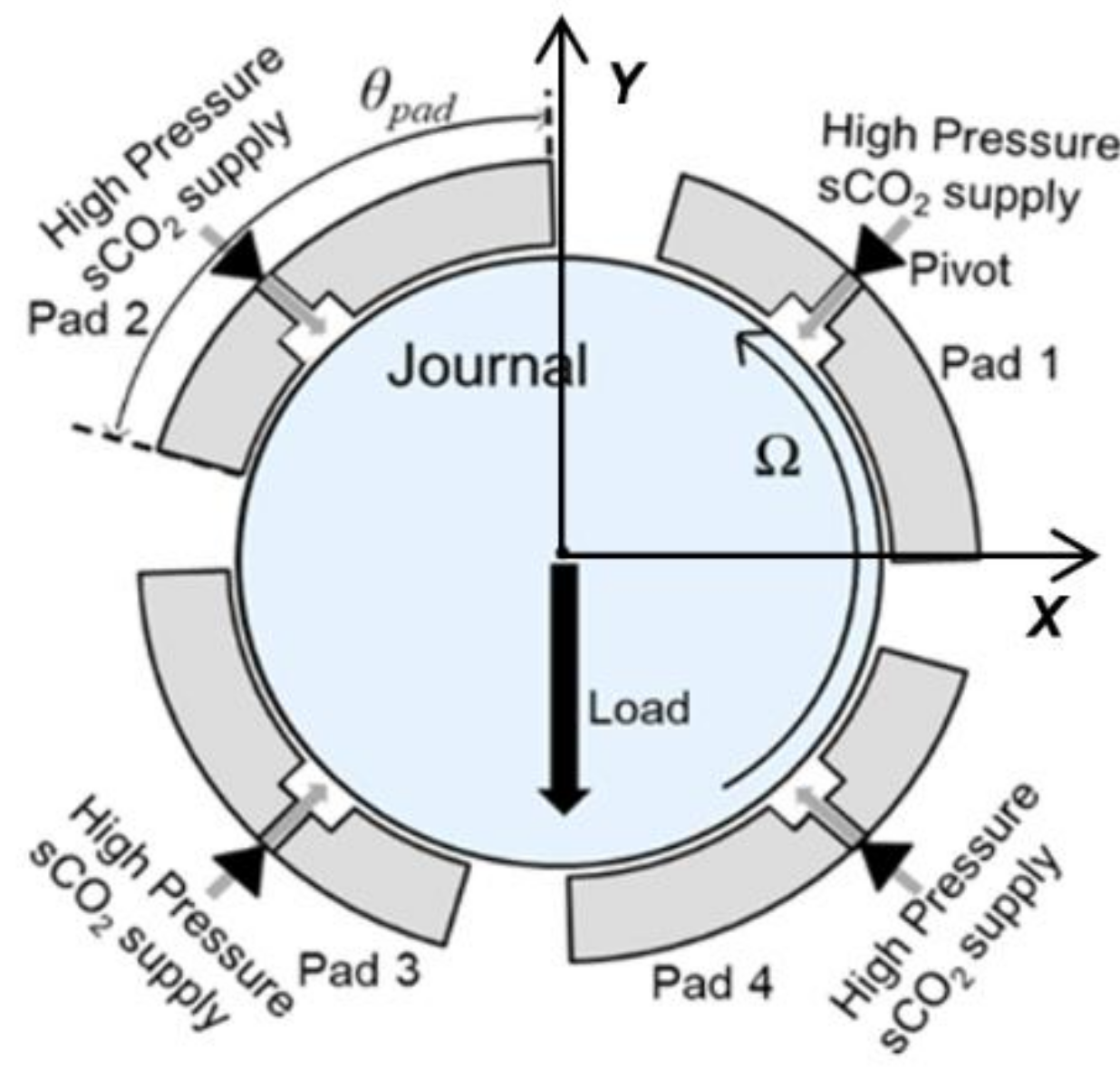
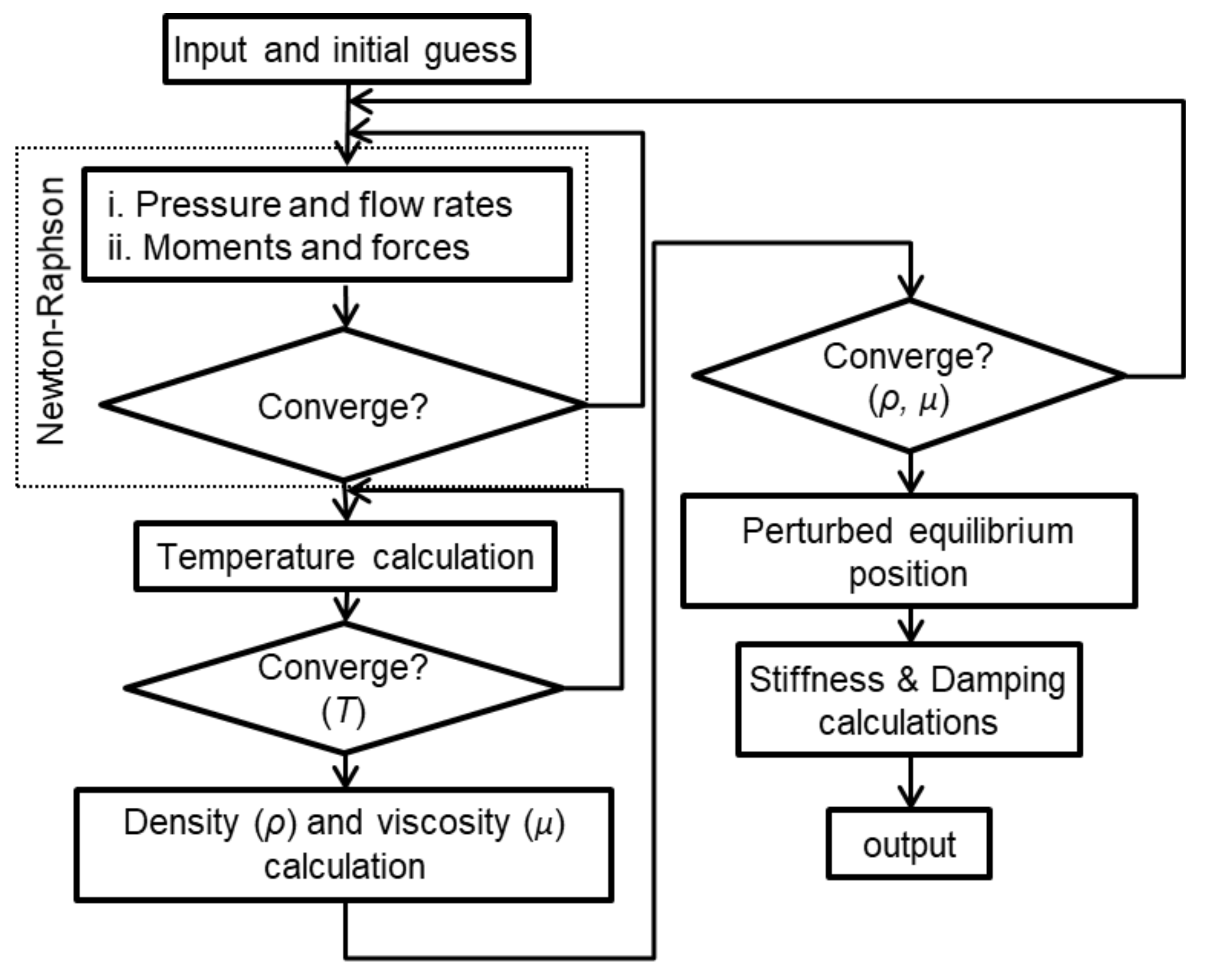
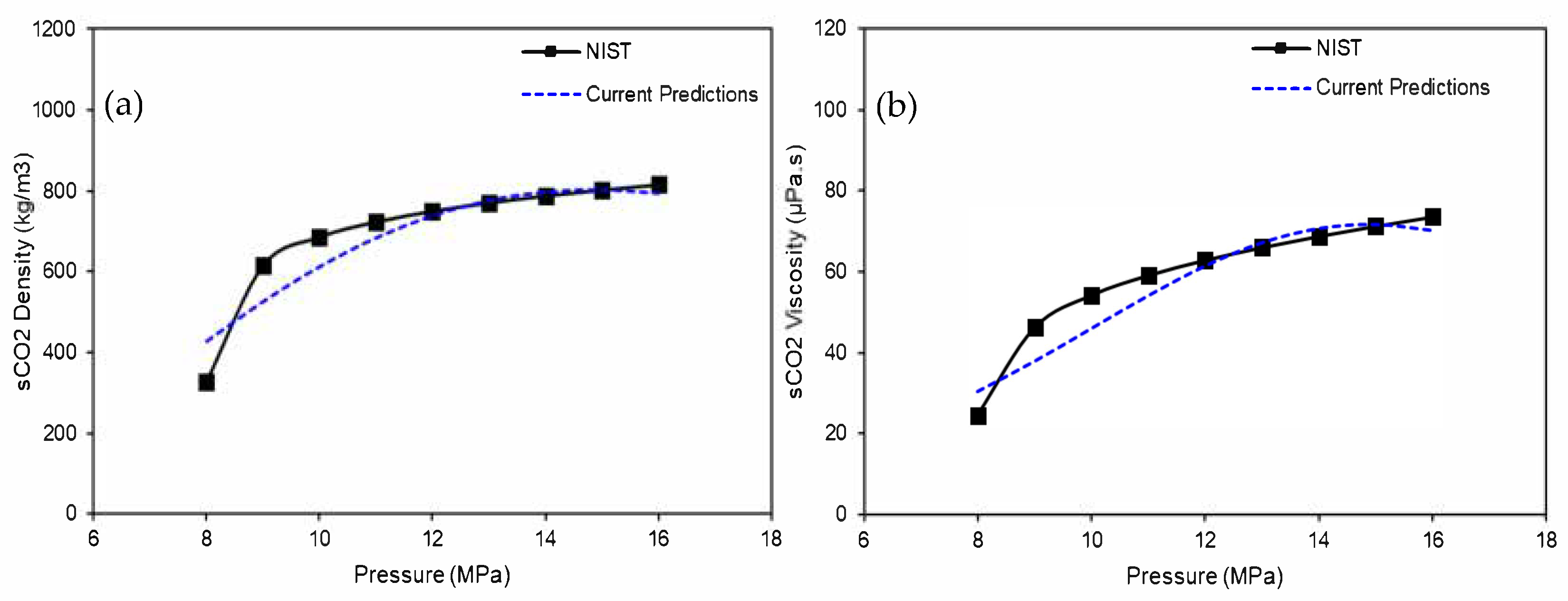
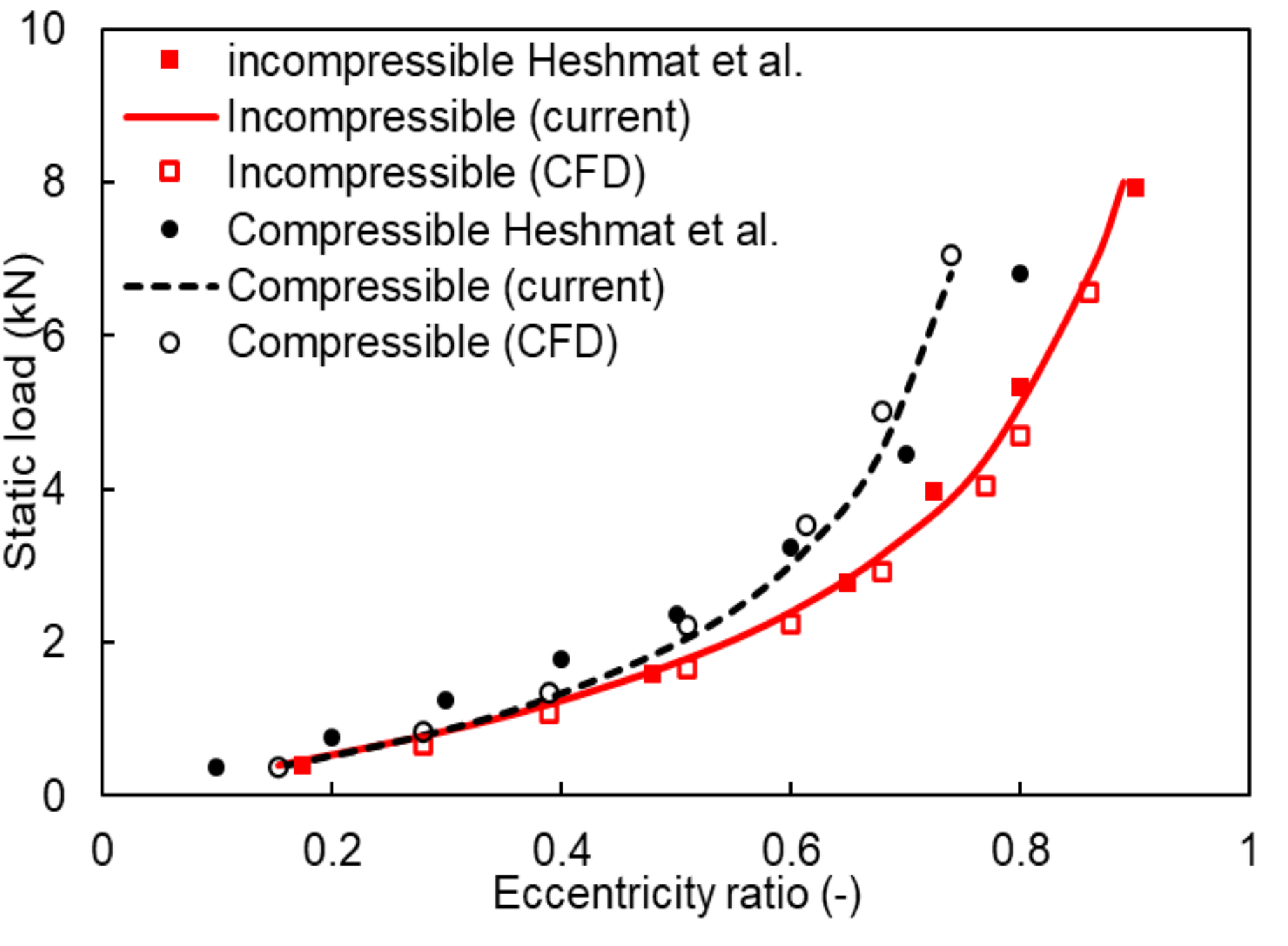
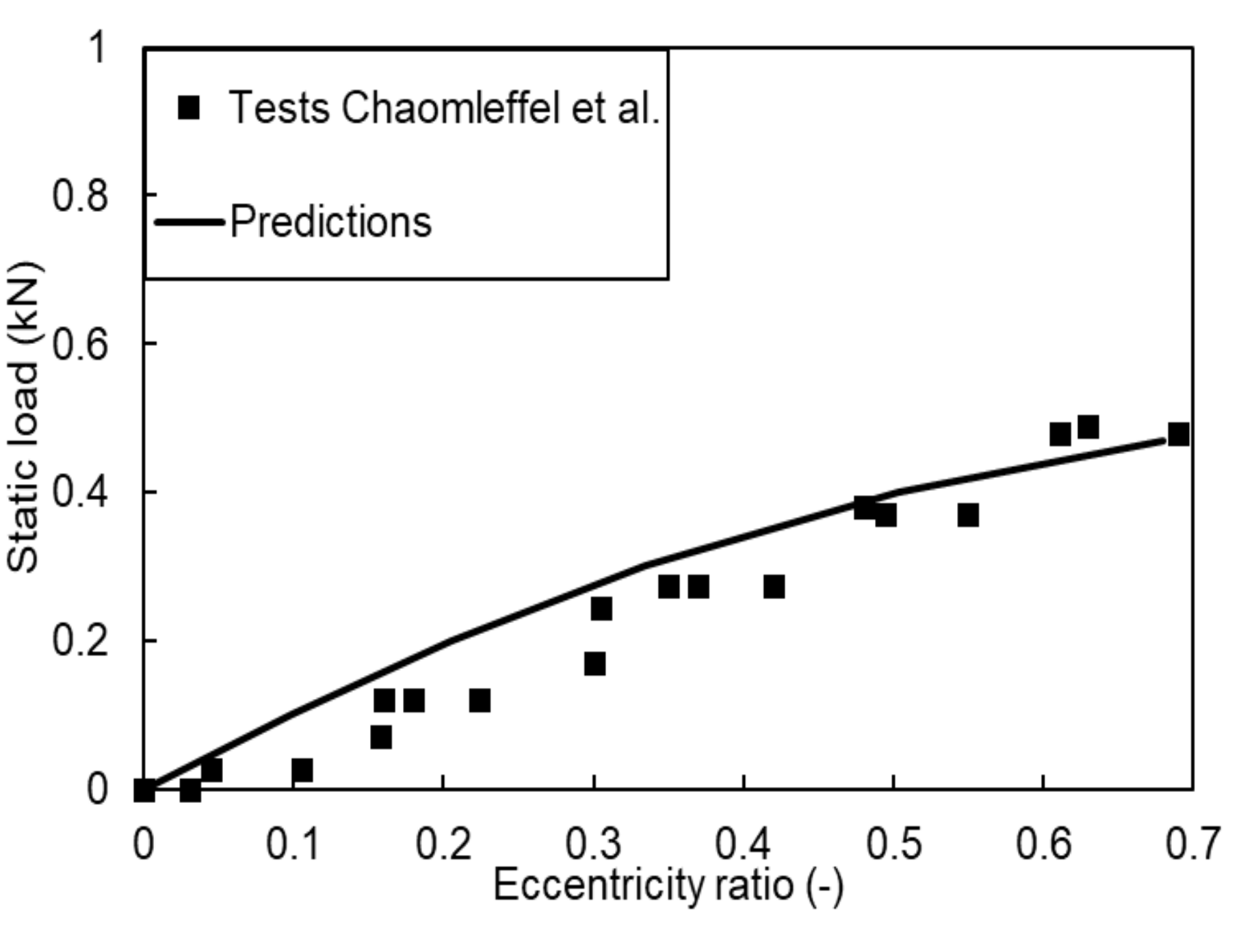

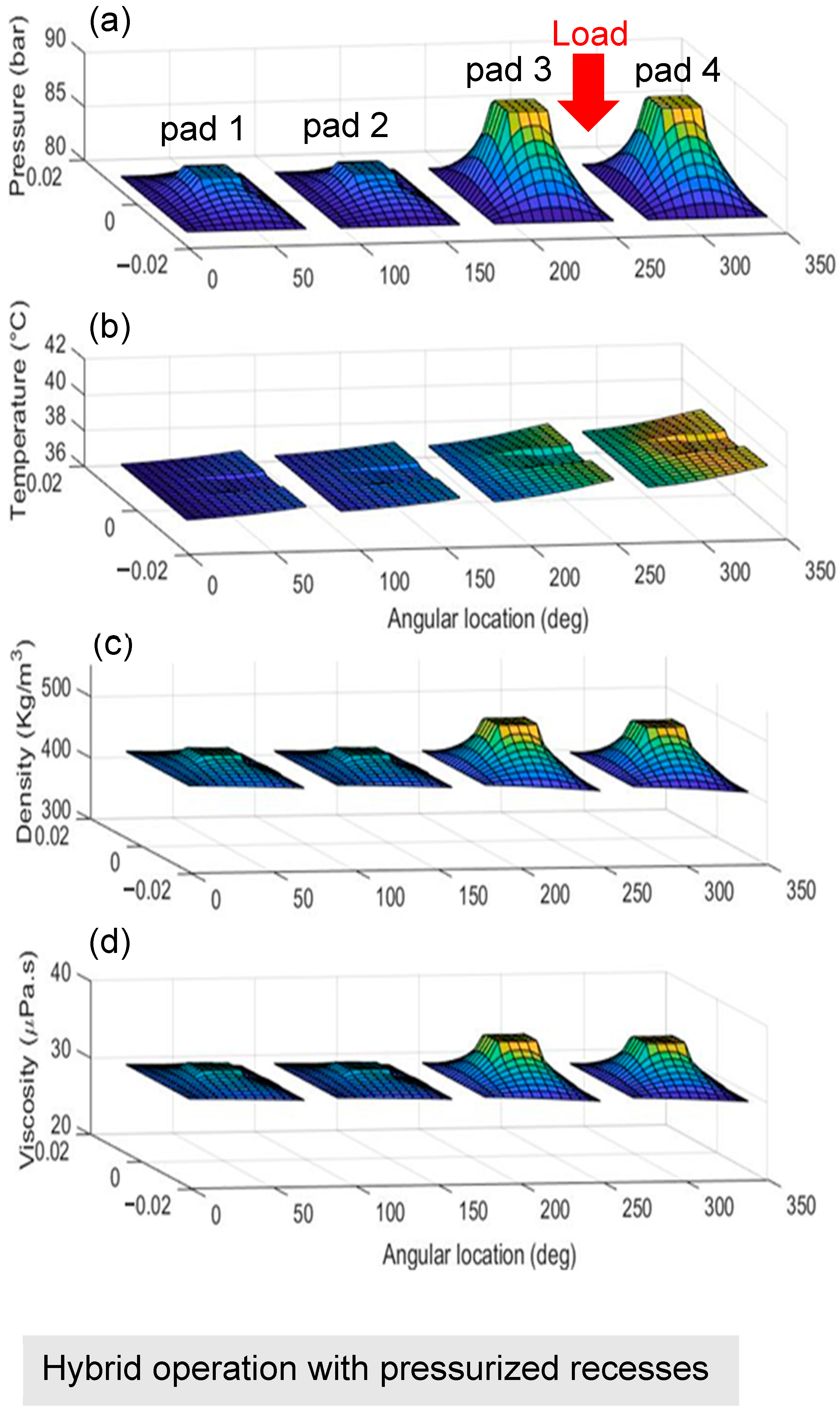
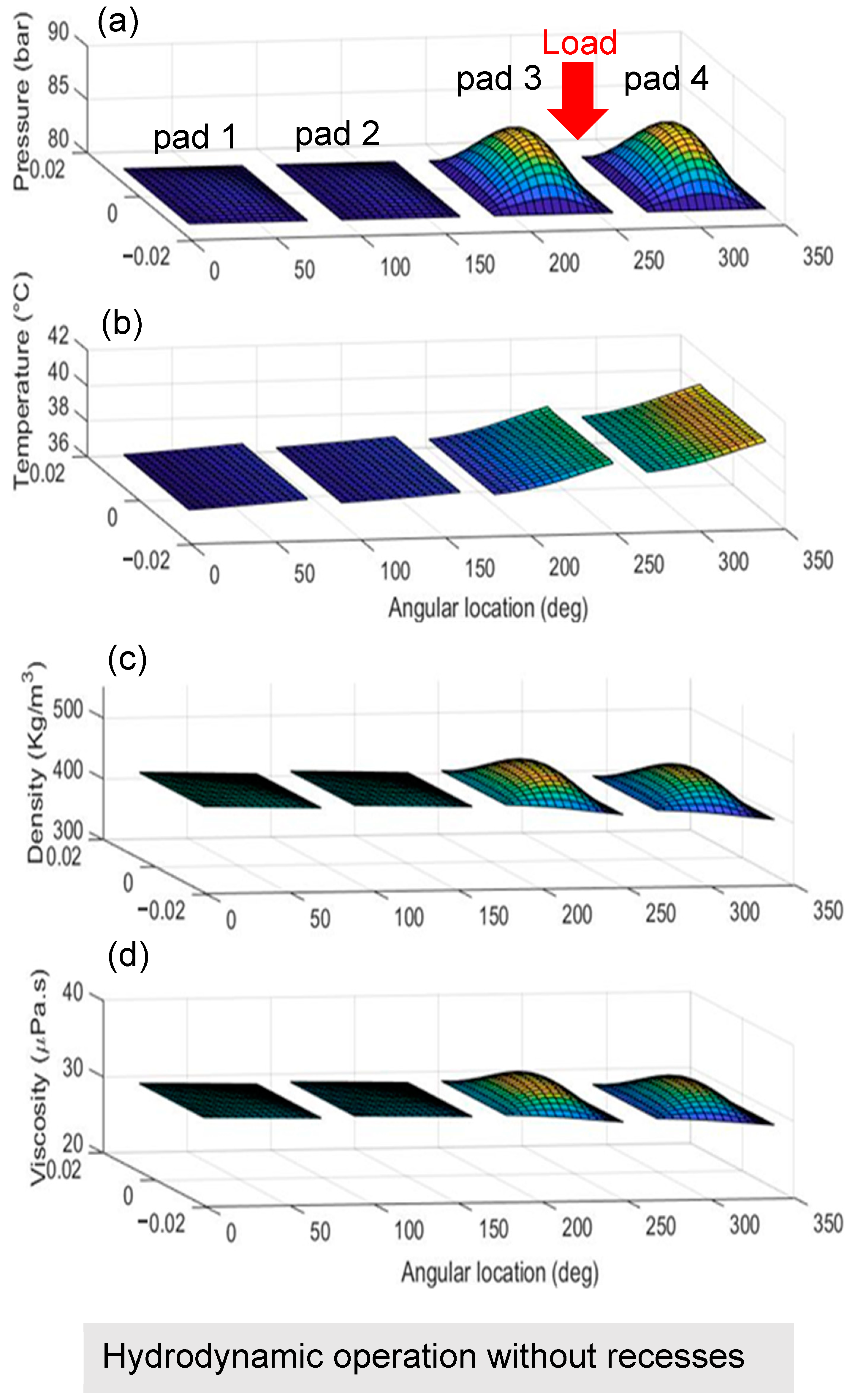

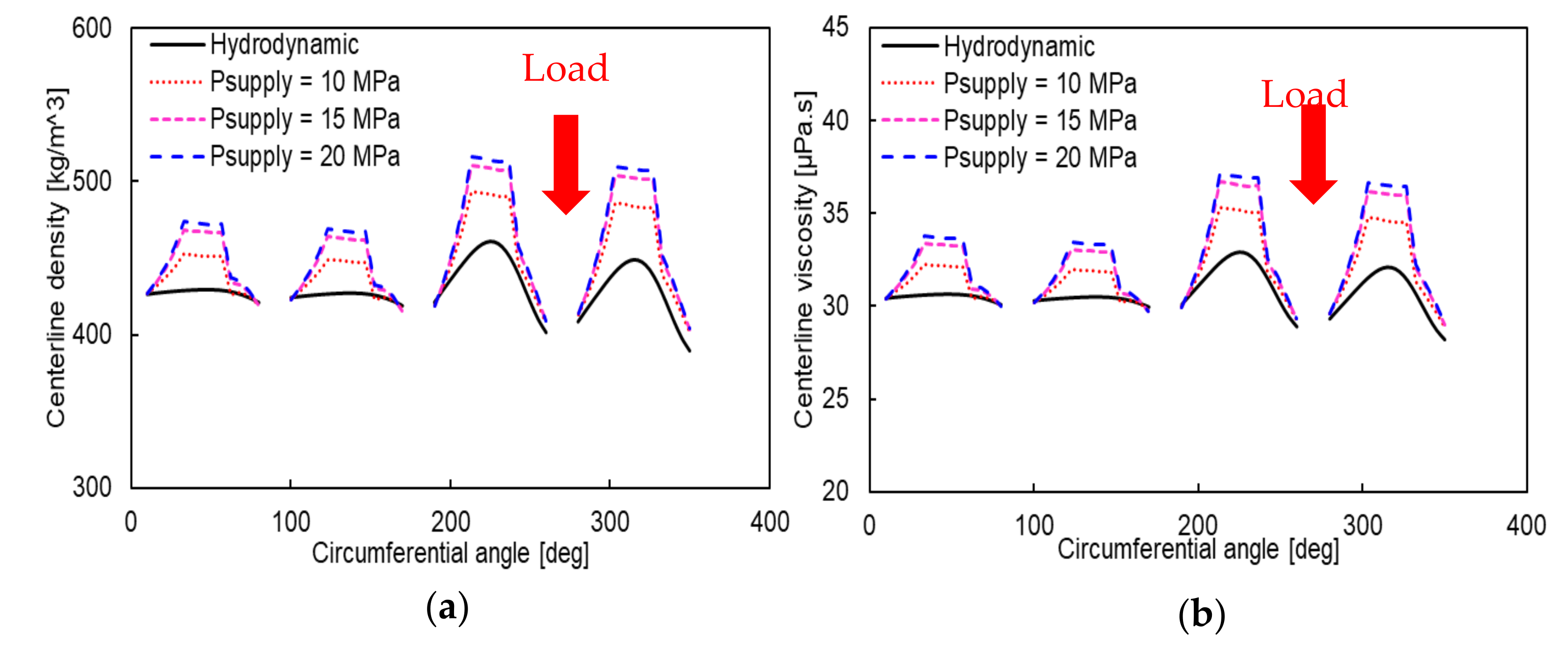
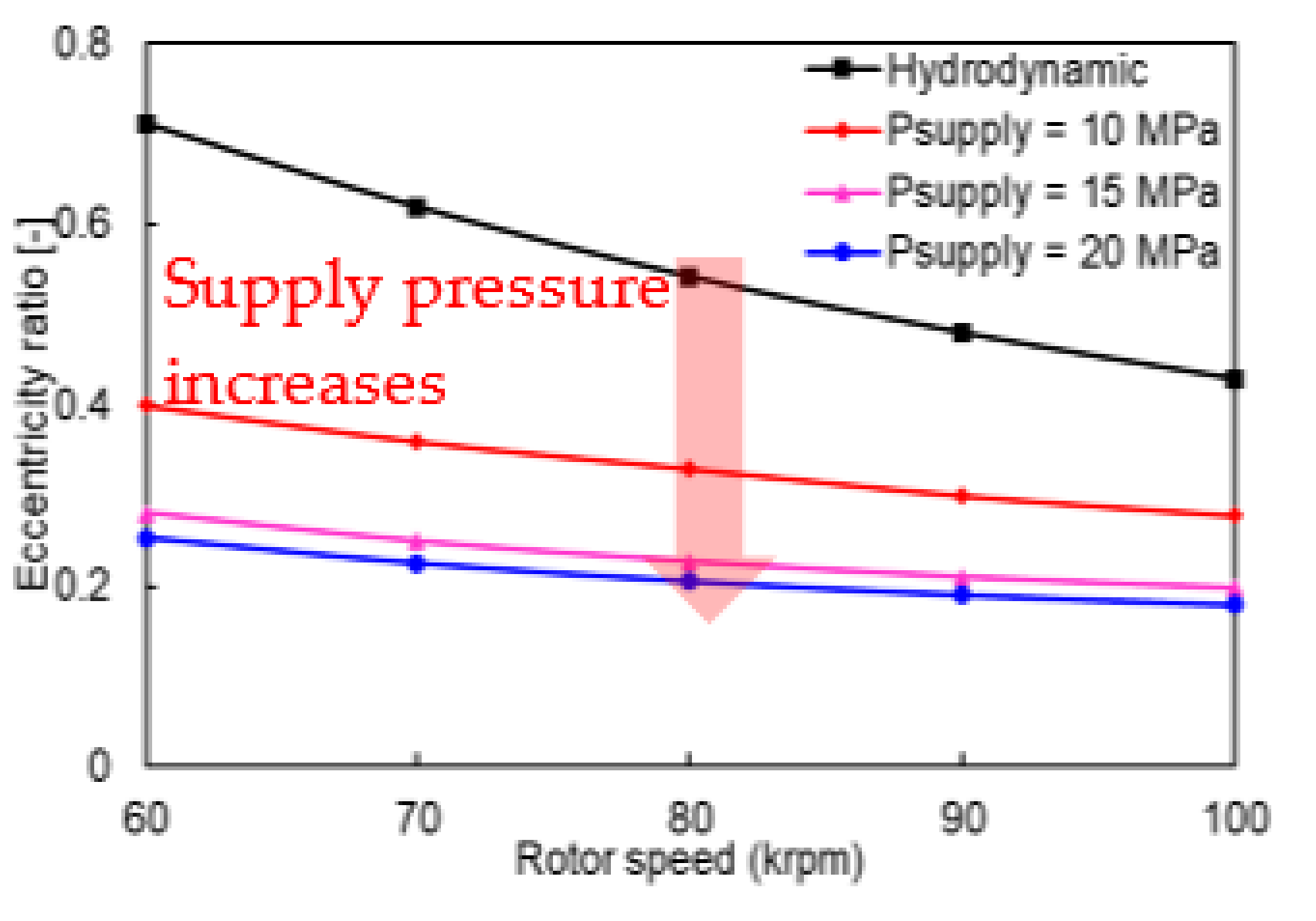
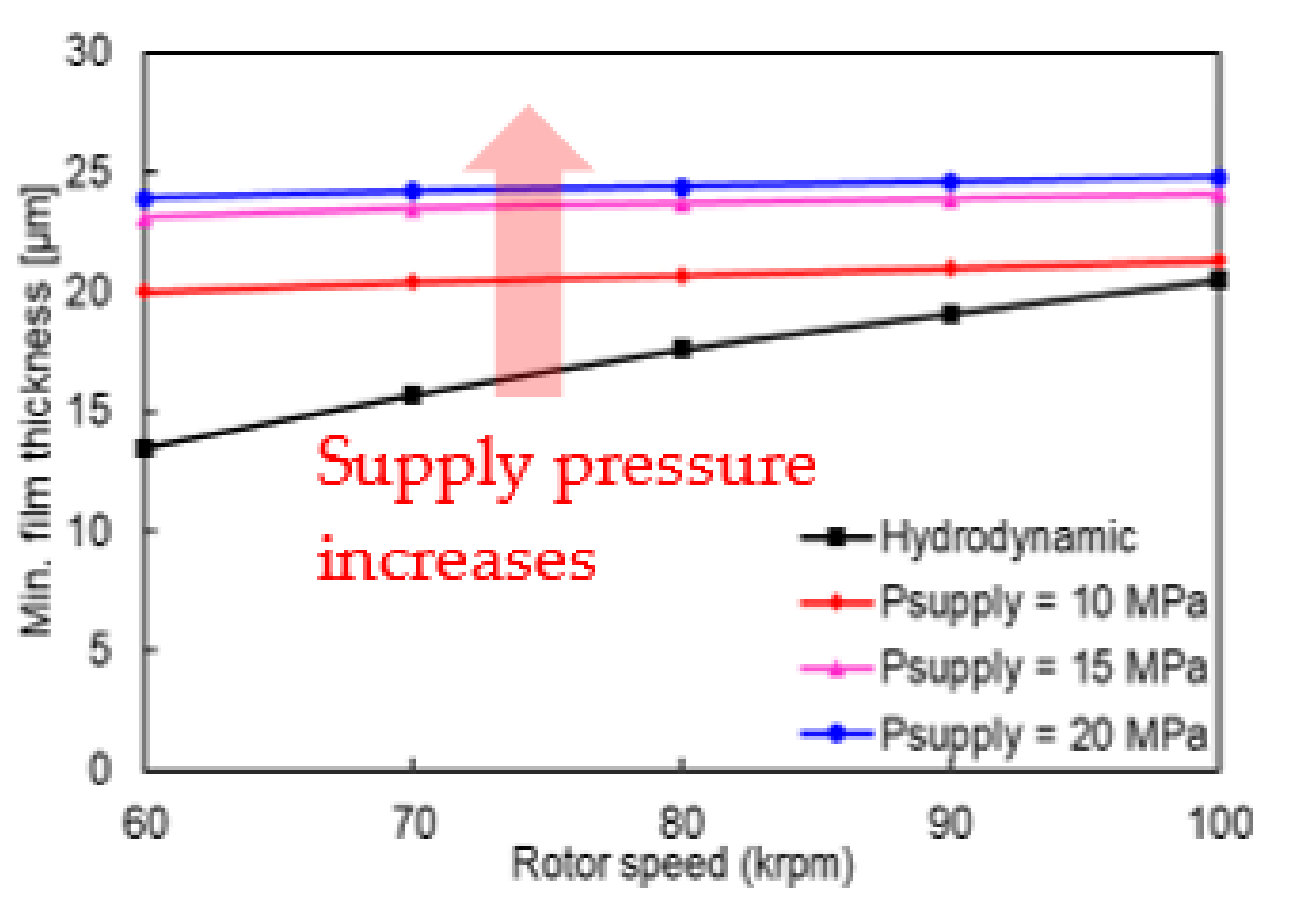
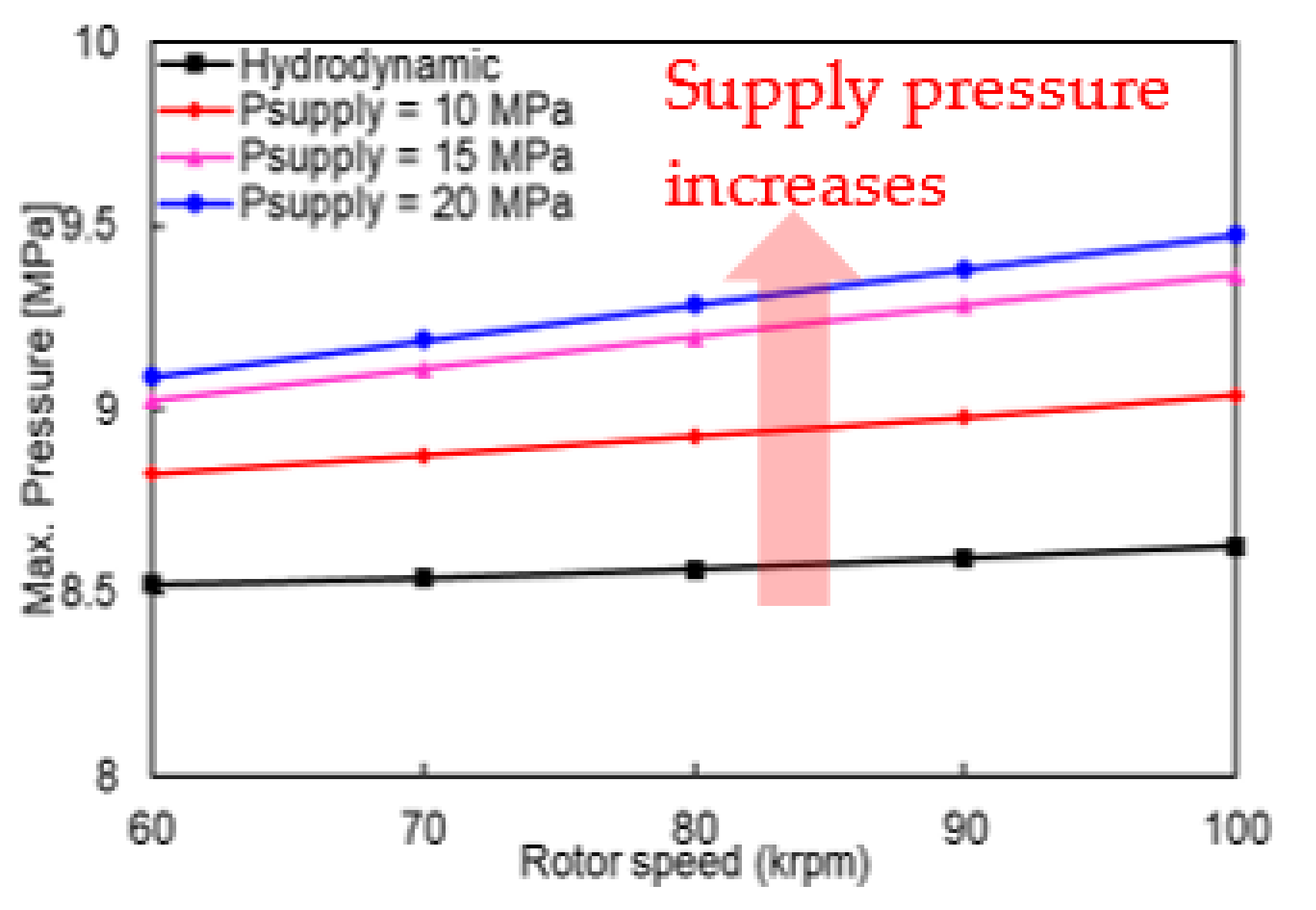
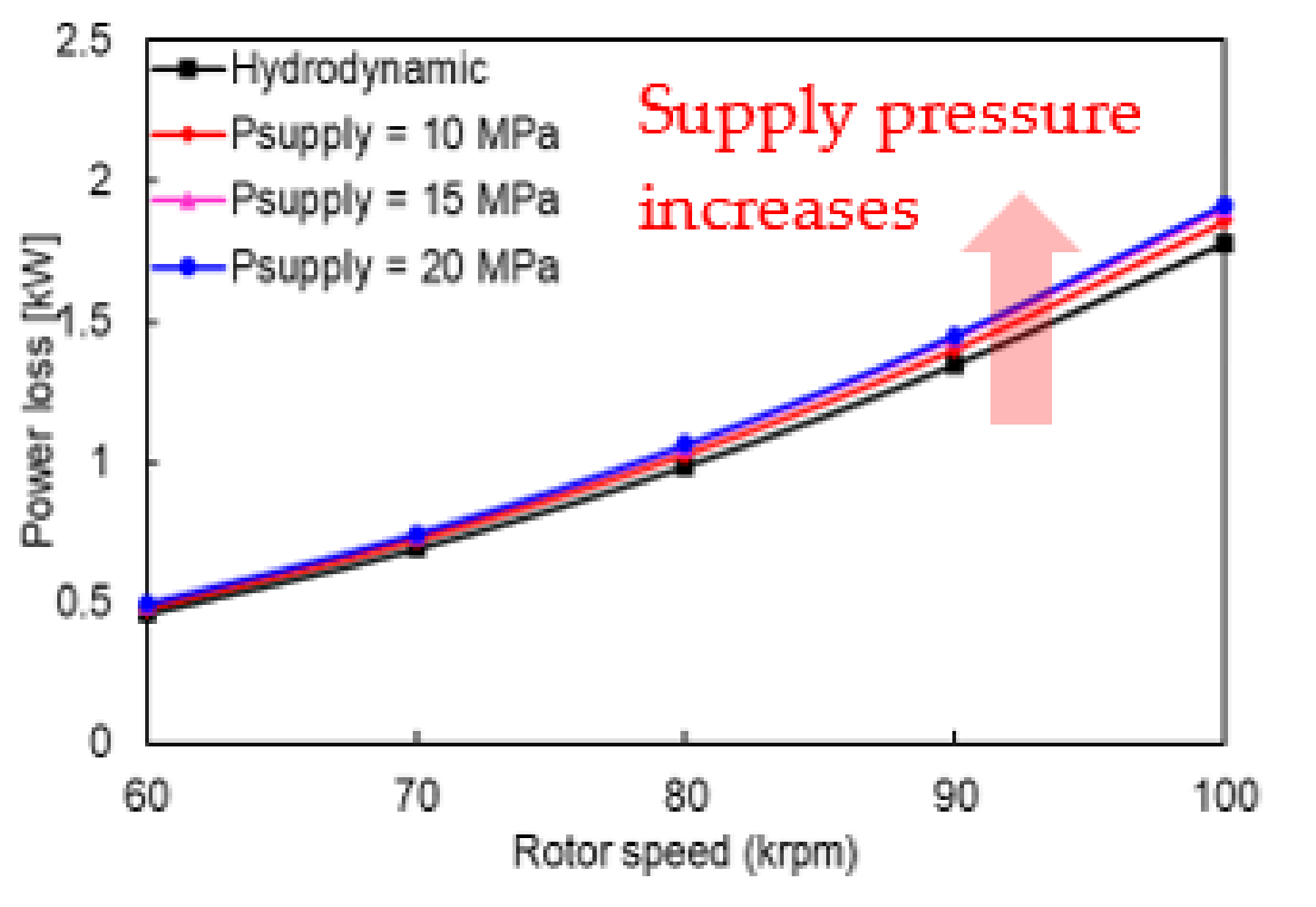
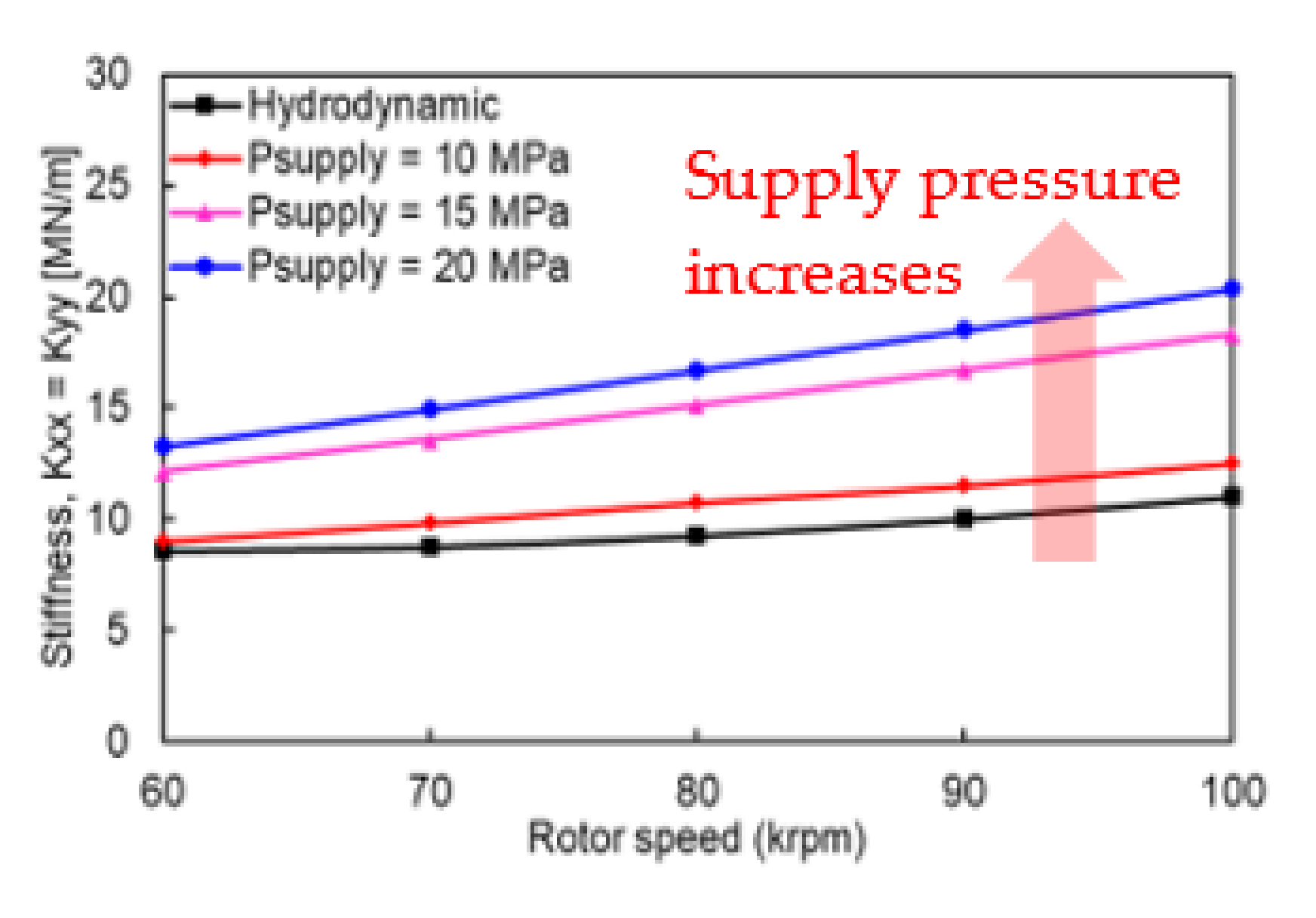
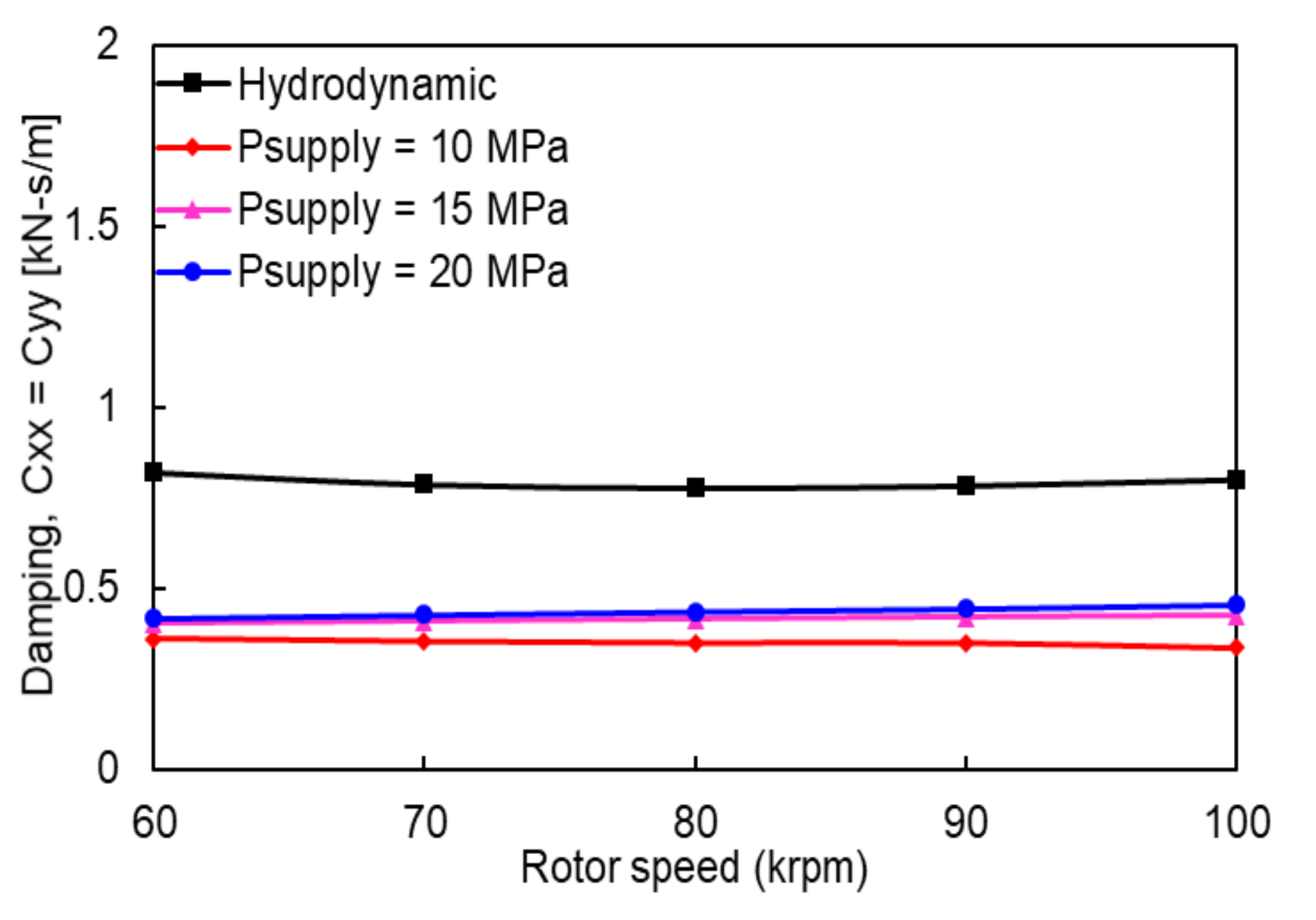
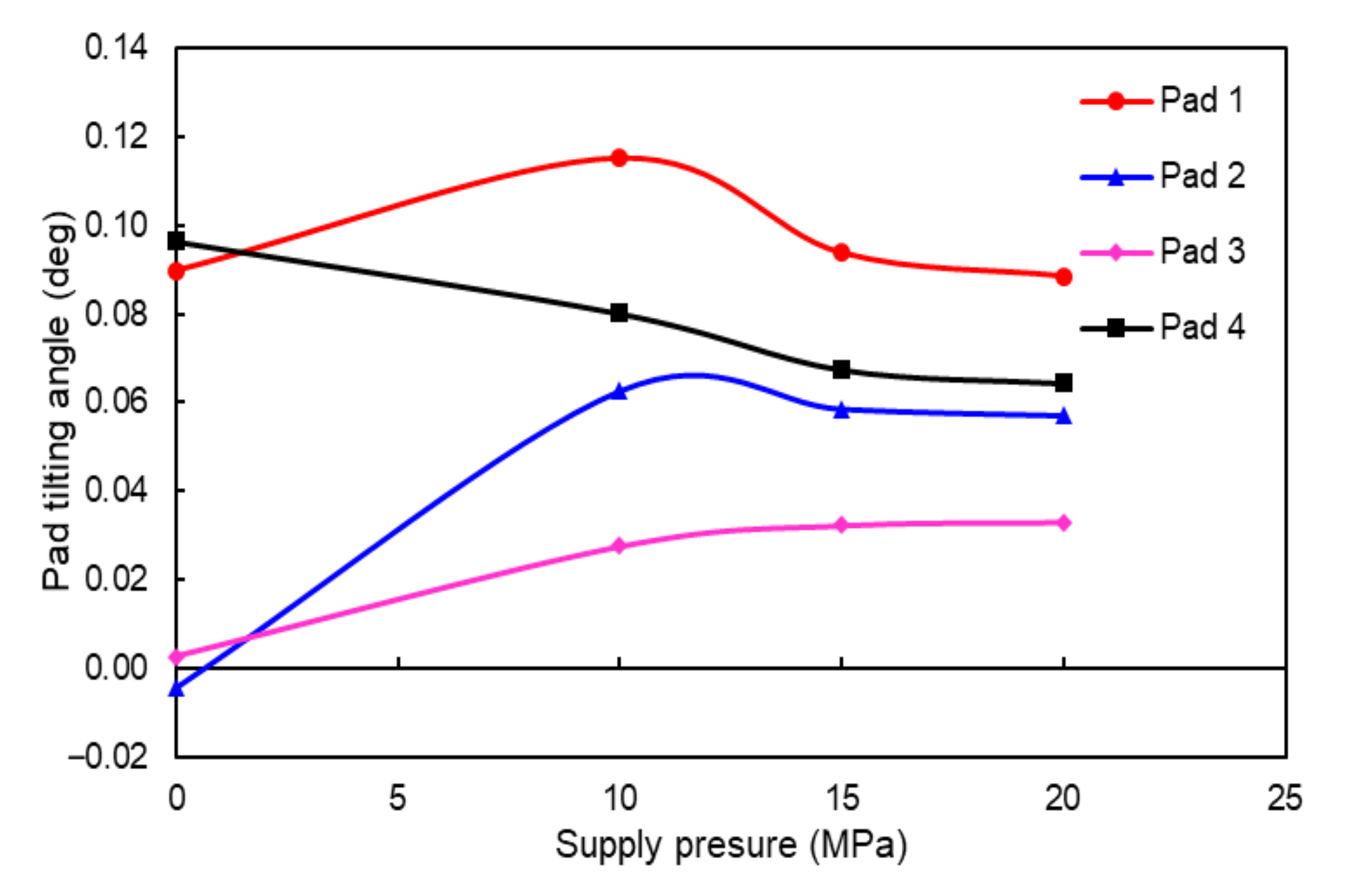
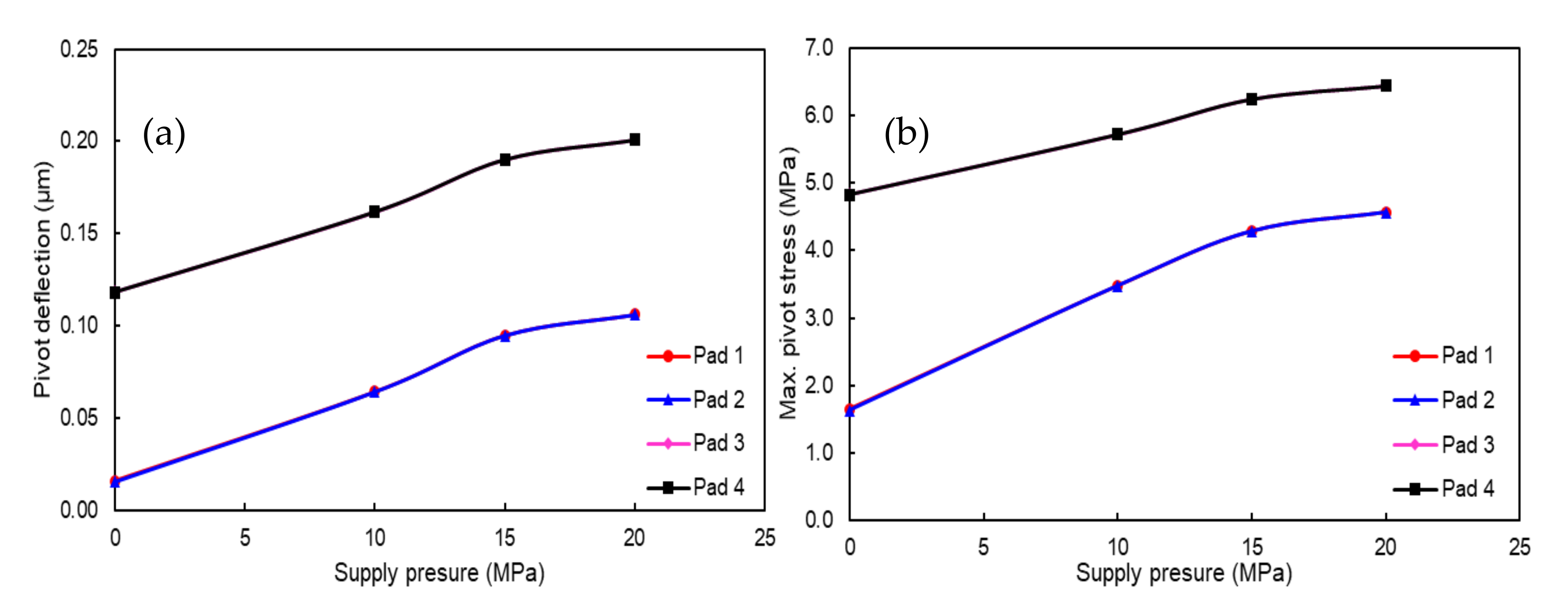
| Parameters | Values | |
|---|---|---|
| Load configuration | LBP | |
| Journal diameter, D (mm) | 25 | |
| Pad axial length, L (mm) | 25 | |
| Number of pads, Npad (-) | 4 | |
| Pad arc angle, θpad (deg) | 70 | |
| TPJB | Pad thickness, tp (mm) | 8.0 |
| Pivot offset (-) | 0.5 | |
| Radial pad clearance, Cp (µm) | 67 | |
| Preload factor, m (-) | 0.5 | |
| Pivot type | Rocker-back | |
| Pivot’s housing radius, Rh (mm) | 21.0 | |
| Pivot | Pivot radius, Rp (mm) | 18.0 |
| Rocker-back length, LR (mm) | 25.0 | |
| Young’s modulus, E (GPa) | 200 | |
| Recess type | Rectangular | |
| Circumferential length of recess, l (mm) | 5.0 | |
| Recess | Axial length of recess, b (mm) | 5.0 |
| Depth of recess, Dr (mm) | 0.1 | |
| Orifice diameter, do (mm) | 0.5 | |
| Orifice discharge coefficient, Cd | 0.68 | |
| Lubricant type | sCO2 | |
| Pressure, Pa (MPa) | 8.0 | |
| Lubricant | Temperature, Ta (°C) | 37 |
| Density, ρ0 (kg/m3) | 426.6 | |
| Viscosity, µ0 (µPa·s) | 30.4 | |
Publisher’s Note: MDPI stays neutral with regard to jurisdictional claims in published maps and institutional affiliations. |
© 2022 by the authors. Licensee MDPI, Basel, Switzerland. This article is an open access article distributed under the terms and conditions of the Creative Commons Attribution (CC BY) license (https://creativecommons.org/licenses/by/4.0/).
Share and Cite
Mehdi, S.M.; Kim, T.H. Computational Model Development for Hybrid Tilting Pad Journal Bearings Lubricated with Supercritical Carbon Dioxide. Appl. Sci. 2022, 12, 1320. https://doi.org/10.3390/app12031320
Mehdi SM, Kim TH. Computational Model Development for Hybrid Tilting Pad Journal Bearings Lubricated with Supercritical Carbon Dioxide. Applied Sciences. 2022; 12(3):1320. https://doi.org/10.3390/app12031320
Chicago/Turabian StyleMehdi, Syed Muntazir, and Tae Ho Kim. 2022. "Computational Model Development for Hybrid Tilting Pad Journal Bearings Lubricated with Supercritical Carbon Dioxide" Applied Sciences 12, no. 3: 1320. https://doi.org/10.3390/app12031320
APA StyleMehdi, S. M., & Kim, T. H. (2022). Computational Model Development for Hybrid Tilting Pad Journal Bearings Lubricated with Supercritical Carbon Dioxide. Applied Sciences, 12(3), 1320. https://doi.org/10.3390/app12031320







